Dexmedetomidine_hydrochloride_SDS_MedChemExpress
氢溴酸右美沙芬的剂型研究进展
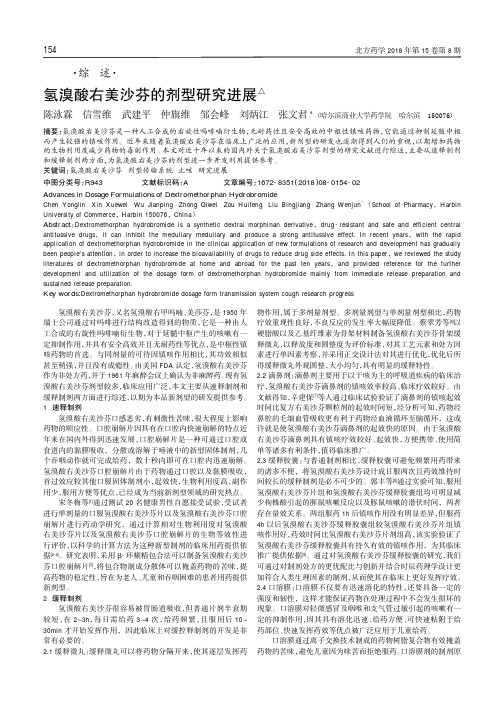
北方药学2018年第15卷第8期·综述·氢溴酸右美沙芬的剂型研究进展△陈泳霖信雪维武建平仲旗维邹会峰刘炳江张文君*(哈尔滨商业大学药学院哈尔滨150076)摘要:氢溴酸右美沙芬是一种人工合成的右旋性吗啡喃衍生物,无耐药性且安全高效的中枢性镇咳药物,它能通过抑制延髓中枢而产生较强的镇咳作用。
近年来随着氢溴酸右美沙芬在临床上广泛的应用,新剂型的研发也逐渐得到人们的重视,以期增加药物的生物利用度减少药物的毒副作用。
本文对近十年以来的国内外关于氢溴酸右美沙芬剂型的研究文献进行综述,主要从速释制剂和缓释制剂两方面,为氢溴酸右美沙芬的剂型进一步开发利用提供参考。
关键词:氢溴酸右美沙芬剂型传输系统止咳研究进展中图分类号:R943文献标识码:A文章编号:1672-8351(2018)08-0154-02Advances in Dosage Formulations of Dextromethorphan HydrobromideChen Yonglin Xin Xuewei Wu Jianping Zhong Qiwei Zou Huifeng Liu Bingjiang Zhang Wenjun*(School of Pharmacy,Harbin University of Commerce,Harbin150076,China)Abstract:Dextromethorphan hydrobromide is a synthetic dextral morphinan derivative,drug-resistant and safe and efficient central antitussive drugs,it can inhibit the medullary medullary and produce a strong antitussive effect.In recent years,with the rapid application of dextromethorphan hydrobromide in the clinical application of new formulations of research and development has gradually been people's attention,in order to increase the bioavailability of drugs to reduce drug side effects.In this paper,we reviewed the study literatures of dextromethorphan hydrobromide at home and abroad for the past ten years,and provided reference for the further development and utilization of the dosage form of dextromethorphan hydrobromide mainly from immediate release preparation and sustained release preparation.Key words:Dextromethorphan hydrobromide dosage form transmission system cough research progress氢溴酸右美沙芬,又名氢溴酸右甲吗喃、美莎芬,是1950年瑞士公司通过对吗啡进行结构改造得到的物质,它是一种由人工合成的右旋性吗啡喃衍生物,对于延髓中枢产生的咳嗽有一定抑制作用,并具有安全高效并且无耐药性等优点,是中枢性镇咳药物的首选。
洋甘菊提取液MSDS英文版

1. IDENTIFICATION OF THE SUBSTANCE/TREPARATION AND THE COMPANY/UNDERTAKING3.HAZARDS IDENTIFICATION4. FIRST AID MEASURESMATERIAL SAFETY DATA SHEETProduct name:Supplier:Tel:EMERGENCY OVERVIEW: May cause skin irritation and/or dermatitisPrinciple routes of exposure: Inhalation: Ingestion: Skin contact: Eye contact:SkinMay cause irritation of respiratory tract May be harmful if swallowed May cause allergic skin reaction Avoid contact with eyesStatements of hazard MAY CAUSE ALLERGIC SKIN REACTION.Statements of Spill of Leak Label Eliminate all ignition sources. Absorb and/or contain spill with inert materials (e.g., sand, vermiculite). Then place in appropriate container. For large spills, use water spray to disperse vapors, flush spill area. Prevent runoff from entering waterways or sewers.General advice:POSITION/INFORMATION ON INGREDIENTSInhalation:Skin contact:Ingestion:Eye contact:Protection of first – aiders:Medical conditions aggravated by exposure: In the case of accident or if you fell unwell, seek medical advice immediately (show the label where possible).Move to fresh air, call a physician immediately.Rinse immediately with plenty of water and seek medical adviceDo not induce vomiting without medical advice.In the case of contact with eyes, rinse immediately with plenty of water and seek medical advice.No information availableNone knownSuitable extinguishing media:Specific hazards:Special protective equipment for firefighters:Flash point:Autoignition temperature:NFPA rating Use dry chemical, CO2, water spray or “alcohol” foam Burning produces irritant fumes.As in any fire, wear self-contained breathing apparatus pressure-demand, MSHA/NIOSH (approved or equivalent) and full protective gearNot determinedNot determinedNFPA Health: 1 NFPA Flammability: 1 NFPA Reactivity: 0Personal precautions: Environmental precautions: Methods for cleaning up: Use personal protective equipment.Prevent product from entering drains.Sweep up and shovel into suitable containers for disposalStorage:7. HANDLING AND STORAGE5.FIRE-FIGHTING MEASURES6. ACCIDENTAL RELEASE MEASURESRoom temperature Handling:Safe handling advice: Incompatible products:Use only in area provided with appropriate exhaust ventilation.Wear personal protective equipment.Oxidising and spontaneously flammable productsEngineering measures: Respiratory protection: Skin and body protection:Eye protection: Hand protection: Hygiene measures:Ensure adequate ventilation.Breathing apparatus only if aerosol or dust is formed. Usual safety precautions while handling the product will provide adequate protection against this potential effect. Safety glasses with side-shieldsPVC or other plastic material glovesHandle in accordance with good industrial hygiene and safety practice.Melting point/range: Boiling point/range: Density: Vapor pressure: Evaporation rate: Vapor density: Solubility (in water): Flash point:Autoignition temperature:No Data available at this time. No Data available at this time. No data available No data available No data available No data available No data available Not determined Not determinedStability: Stable under recommended storage conditions. Polymerization: None under normal processing.Hazardous decomposition products: Thermal decomposition can lead to release of irritating gases and vapours such as carbon oxides.Materials to avoid: Strong oxidising agents.10. STABILITY AND REACTIVITY9. PHYSICAL AND CHEMICAL PROPERTIES8. EXPOSURE CONTROLS/PERSONAL PROTECTION11. TOXICOLOGICAL INFORMATIONConditions to avoid: Exposure to air or moisture over prolonged periods.Product information Acute toxicityChronic toxicity:Local effects: Chronic exposure may cause nausea and vomiting, higher exposure causes unconsciousness.Symptoms of overexposure may be headache, dizziness, tiredness, nausea and vomiting.Specific effects:May include moderate to severe erythema (redness) and moderate edema (raised skin), nausea, vomiting,headache.Primary irritation: Carcingenic effects: Mutagenic effects: Reproductive toxicity:No data is available on the product itself. No data is available on the product itself. No data is available on the product itself. No data is available on the product itself.Mobility:Bioaccumulation: Ecotoxicity effects: Aquatic toxicity:No data available No data available No data availableMay cause long-term adverse effects in the aquatic environment.12. ECOLOGICAL INFORMATION13. DISPOSAL CONSIDERATIONSWaste from residues/unused products:Contaminated packaging:Waste disposal must be in accordance with appropriate Federal, State and local regulations. This product, if unaltered by use, may be disposed of treatment at a permitted facility or as advised by your local hazardous waste regulatory authority. Residue from fires extinguished with this material may be hazardous.Do not re-use empty containers.UN/Id No:Not regulated14. TRANSPORT INFFORMATIONDOTProper shipping name: Not regulatedTGD(Canada)WHMIS hazard class: Non - controlledIMDG/IMOIMDG – Hazard Classifications Not ApplicableIMO – labels:15. REGULATORY INFOTMATION International Inventories16. OTHER INFORMATIONPrepared by: Health & SafetyDisclaimer: The information and recommendations contained herein are based upon tests believed to be reliable.However, XABC does not guarantee the accuracy or completeness NOR SHALL ANY OF THIS INFORMATION CONSTITUTE A WARRANTY, WHETHER EXPRESSED OR IMPLIED, AS TO THE SAFETY OF THE GOOD, THE MERCHANTABILITY OF THE GOODS, OR THE FITNESS OF THE FITNESS OF THE GOODS FOR A PARTICULAR PURPOSE. Adjustment to conform to actual conditions of usage maybe required. XABC assumes no responsibility for results obtained or for incidental or consequential damages, including lost profits arising from the use of these data. No warranty against infringement of any patent, copyright or trademark is made or implied.End of safety data sheet。
美国留学的常用非处方药

美国留学的常用非处方药美国留学必备的常用非处方药美国留学必备常用非处方药。
在美国留学难免有个痛疼脑热,今天店铺给大家介绍一下美国常用非处方药。
Loperamide 是最有效的治疗腹泻的非处方药。
药片和液体形式都适宜儿童服用。
但该药物不能减缓消化不良症状,建议搭配Pepto Bismol服用。
推荐品牌:Imodium, Pepto BismolPseudoephedrine 是唯一投放在市场上,用于治疗由过敏或上呼吸道感染引发的鼻塞、镇咳、祛痰药。
该药的口服溶液也适宜六岁以上的患病儿童。
它最常见的副作用是刺激肾上腺素升高,从而导致心率过快,心悸,高血压等症状。
推荐品牌:SudafedMeclizine是一款常见止吐产品,可以作为处方药或者成药。
它对于治疗晕动病(指晕船、晕车、晕飞机)非常有效。
最常见的不良反应是导致困乏嗜睡。
推荐品牌:Bonine, DramamineRanitidine 是一款非常有效的缓解胃酸过多所致的胃痛、胃灼热(烧心)非处方药。
市面上同类用于减轻胃酸或者反胃的.药物,还有Prilosec、Prevacid、Zegerid等。
其中,Prevacid适合孕期服用,缓解孕妇胃灼热。
推荐品牌:ZantacHydrocortisone cream里百分之一的药物成分是类固醇膏。
它对于治疗由感染或过敏引起的轻微皮肤不适非常有效。
患病成人或儿童均宜使用。
同类产品还推荐diphenhydramine cream。
推荐品牌:CortizoneNeosporin ointment是一款常用的抗菌药膏,主要用于治疗轻微皮肤割伤裂伤,避免再度感染。
推荐品牌:NeosporinClotrimazole主要用于治疗真菌感染。
一般通过局部涂抹来治疗皮肤上的真菌感染,比如癣菌病,尿布疹等。
用于治疗女性宫颈感染时,可以选择其栓剂或者膏药形式。
推荐品牌:LotriminIbuprofen是一种非类固醇的消炎药,也是世界卫生组织指定的必备药品之一。
法莫替丁

取本品约0.12g,精密称定,加冰醋酸20mL与醋酐5mL溶解后,加结晶紫指示液1滴,用高氯酸滴定液 (0.1mol/L)滴定至溶液显绿色,并将滴定的结果用空白试验校正。每1mL高氯酸滴定液(0.1mol/L)相当于 16.87mg的C8H15N7O2S3。
H2受体阻滞药。
遮光,密封保存。
1、法莫替丁片。 2、法莫替丁注射液。 3、法莫替丁胶囊。 4、法莫替丁颗粒。
安全信息
安全术语
风险术语
S22:Do not breathe dust. 不要吸入粉尘。 S24/25:Avoid contact with skin and eyes. 避免皮肤和眼睛接触。
R20/21/22:Harmful by inhalation, in contact with skin and if swallowed. 吸入、与皮肤接触和吞食是有害的。
摩尔折射率:79.06 摩尔体积(cm3/mol):183.5 等张比容(90.2K):576.5 表面张力(dyne/cm):97.3 极化率(10-24cm3):31.34
疏水参数计算参考值(XlogP):-0.6 氢键供体数量:4 氢键受体数量:9 可旋转化学键数量:7 拓扑分子极性表面积(TPSA):176 重原子数量:20 表面电荷:0 复杂度:469 同位素原子数量:0 确定原子立构中心数量:0 不确定原子立构中心数量:0
3
分子结构数据
4
计算化学数据
5
用途
化学式:C8H15N7O2S3 分子量:337.445 CAS号:-35-6
密度:1.83 g/cm3 熔点:163-164°C 沸点:662.4℃ 闪 点 : 3 5 4 . 4 ºC 折射率:1.808 外观:白色结晶性粉末 溶解性:在甲醇中微溶,在丙酮中极微溶解,在水或氯仿中几乎不溶,在冰醋酸中易溶
脂肪干细胞成脂诱导及鉴定程序

脂肪干细胞成脂诱导及鉴定程序一、试剂准备(一)成脂分化诱导液(Adipogenic Medium, AM)配方【1】:试剂名称浓度商品信息1.极限必须培养基(Dulbecco’S Modified Eagle Medium ,DMEM) 1.0 L(SH30021.01B, Hyclone)2.胎牛血清(Fetal Bovine Serum,FBS)10%(ES-009-B, Millipore)3.青霉素/链霉素(Penicillin/Streptomycin)1%(TMS-AB2C, CHEMICON)4.地塞米松(Dexamethasone,DM) 1µmo/L 分子量:392.46(D4902-25MG, Sigma)5.胰岛素(Insulin, IS) 10 µmol/L 分子量:5808(91077C—1g, Sigma)6.3-异丁基-1-甲基黄嘌呤(Isobutylmethylxanthine,IBMX) 0.5 mmol/L 分子量:222.24( I5879-100MG, Sigma)7.吲哚美辛(Indomethacin,ID) 200 µmol/L 分子量:357.79(I7378—5G, Sigma)(二)成脂分化诱导液浓储液配制试剂名称质量浓缩倍数配制方法1.Stock A胎牛血清1ml/管1X( liquid)分装1ml/管X100 保存:-20℃2.Stock B青霉素/链霉素0.1ml/管100X( liquid)分装0.1ml/管X100 保存:-20℃3.Stock C地塞米松0.0117738 g 1000X 溶于30ml 无水乙醇(0.1%) 分装0.1ml/管X300保存:-20℃4.Stock D胰岛素0.05808 g100X 溶于10ml Hcl(0.1 mol/L,PH2.0) 分装0.1ml/管X100保存:4℃5.Stock E3-异丁基-1-甲基黄嘌呤0.05556 g 200X 溶于2.5ml DMSO(0. 5%) 分装0.05ml/EP管X50 保存:-20℃6.Stock F吲哚美辛0.07155 g 500X 溶于2ml 无水乙醇(0.2%) 分装0.02ml/管X100保存:-20℃(三)成脂分化诱导液工作液配制(10ml)1.取DMEM(L)8.72ml加入15ml离心管(BD);2.加1管Stock A(1ml);3.加1管Stock B(0.1ml);4.取1管Stock C(0.1ml)溶解,加入0.01ml;5.加1管Stock E(0.05ml);6.加1管Stock F(0.02ml);7.加1管Stock D(0.1ml);8.测渗透压,调pH7.2-7.4;9.0.22µm微孔过滤,4℃贮存,一周内使用。
聚二甲基硅氧烷msds英文版

聚二甲基硅氧烷msds英文版Material Safety Data SheetSilicon dioxide, dimethylSection 1: IdentificationProduct name: Silicon dioxide, dimethylChemical formula: (CH3)2SiOCAS number: 63148-62-9Synonyms: Dimethicone, Poly(dimethylsiloxane), Silicone oil Section 2: Hazard IdentificationClassification:- Eye irritation category 2- Skin irritation category 2- Specific target organ toxicity - Single exposure category 3 Hazards:- May cause eye irritation.- May cause skin irritation.- May cause respiratory irritation.- May cause drowsiness or dizziness.Section 3: CompositionChemical Name CAS number Concentration Silicon dioxide, dimethyl 63148-62-9 100% Section 4: First Aid MeasuresEye contact:- Immediately rinse eyes with plenty of water for at least 15 minutes, lifting eyelids occasionally. If irritation persists, seek medical attention.Skin contact:- Remove contaminated clothing and wash affected area with soap and water. If irritation occurs, get medical advice.Inhalation:- Move the affected person to fresh air. If breathing becomes difficult, provide oxygen and seek medical attention. Ingestion:- Rinse mouth and drink plenty of water. Do not induce vomiting. Seek medical attention if symptoms occur.Section 5: Fire Fighting MeasuresSuitable extinguishing media:- Use dry chemical, CO2, or foam to extinguish the fire.Section 6: Accidental Release MeasuresPersonal precautions:- Wear appropriate personal protective equipment, such as gloves and safety goggles.Environmental precautions:- Prevent the product from entering drains or water sources. Cleanup methods:- Absorb spill with an inert material, such as sand or vermiculite. Dispose of waste according to local regulations.Section 7: Handling and StorageHandling:- Avoid contact with eyes, skin, and clothing. Use in a well-ventilated area. Do not ingest.Storage:- Store in a cool, dry, well-ventilated area in tightly closed containers. Keep away from heat, sparks, and flame.Section 8: Exposure Controls and Personal Protection Engineering measures:- Ensure adequate ventilation to maintain air levels below occupational exposure limits.Personal protective equipment:- Eye/face protection: Safety glasses or goggles.- Skin protection: Chemical resistant gloves and protective clothing. - Respiratory protection: In case of insufficient ventilation, use NIOSH/MSHA approved respirator.Section 9: Physical and Chemical PropertiesAppearance: Clear, colorless liquidOdor: OdorlessMelting point: -50°CBoiling point: >200°CFlash point: >93°CSpecific gravity: 0.965-0.975 g/cm3Vapor pressure: <0.1 mmHg at 25°CVapor density: >1 (Air=1)Section 10: Stability and ReactivityStability: Stable under normal conditions.Hazardous reactions: None known.Conditions to avoid: Avoid heat, sparks, flame, and other ignition sources.Section 11: Toxicological InformationAcute toxicity:- Oral LD50: >5,000 mg/kg (rat)- Dermal LD50: >5,000 mg/kg (rabbit)Skin irritation:- Rabbit skin irritation: Mild irritantEye irritation:- Rabbit eye irritation: Mild irritantSection 12: Ecological InformationEcotoxicity:- Aquatic toxicity: Not availablePersistence and degradability:- Not readily biodegradableSection 13: Disposal ConsiderationsDisposal methods:- Dispose of waste material in accordance with all local, regional, and national regulations.Section 14: Transport InformationUN Number: Not regulatedUN Proper Shipping Name: Not regulatedTransport hazard class: Not classifiedPacking group: Not applicableSection 15: Regulatory InformationUS federal regulations:- TSCA (Toxic Substances Control Act): Listed- SARA (Superfund Amendments and Reauthorization Act): Not listedSection 16: Other InformationPrepared by: [your company name]Preparation date: [date]Last revision date: [date]Disclaimer: The above information is believed to be accurate, but no guarantee is given or implied. Users must make their own determination of suitability and completeness for their intended use.。
羟乙基淀粉说明书
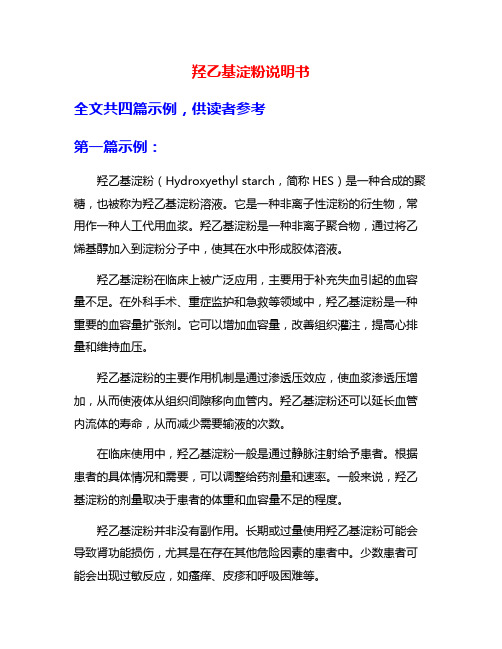
羟乙基淀粉说明书全文共四篇示例,供读者参考第一篇示例:羟乙基淀粉(Hydroxyethyl starch,简称HES)是一种合成的聚糖,也被称为羟乙基淀粉溶液。
它是一种非离子性淀粉的衍生物,常用作一种人工代用血浆。
羟乙基淀粉是一种非离子聚合物,通过将乙烯基醇加入到淀粉分子中,使其在水中形成胶体溶液。
羟乙基淀粉在临床上被广泛应用,主要用于补充失血引起的血容量不足。
在外科手术、重症监护和急救等领域中,羟乙基淀粉是一种重要的血容量扩张剂。
它可以增加血容量,改善组织灌注,提高心排量和维持血压。
羟乙基淀粉的主要作用机制是通过渗透压效应,使血浆渗透压增加,从而使液体从组织间隙移向血管内。
羟乙基淀粉还可以延长血管内流体的寿命,从而减少需要输液的次数。
在临床使用中,羟乙基淀粉一般是通过静脉注射给予患者。
根据患者的具体情况和需要,可以调整给药剂量和速率。
一般来说,羟乙基淀粉的剂量取决于患者的体重和血容量不足的程度。
羟乙基淀粉并非没有副作用。
长期或过量使用羟乙基淀粉可能会导致肾功能损伤,尤其是在存在其他危险因素的患者中。
少数患者可能会出现过敏反应,如瘙痒、皮疹和呼吸困难等。
在使用羟乙基淀粉时,医生必须根据患者的具体情况慎重考虑,并且密切监测患者的肾功能和血容量情况。
应该避免过量使用羟乙基淀粉,以减少副作用的发生。
羟乙基淀粉是一种有效的血容量扩张剂,可以在一些急性失血和循环不足的情况下使用。
在使用时必须谨慎,并且在临床监测下使用,以确保患者的安全和有效治疗。
第二篇示例:羟乙基淀粉,又称为HEC,是一种水溶性聚合物,常用在化妆品、药品、食品、建筑材料等领域。
它具有优异的增稠、絮凝、抗皱、保湿等功能,被广泛应用于各种领域。
下面我们来详细了解一下羟乙基淀粉的相关信息。
一、羟乙基淀粉的性质羟乙基淀粉是一种无色至淡黄色的粉末,具有优异的溶解性和稳定性。
它在水中能够迅速溶解,形成透明的胶体溶液,并且具有较好的温度稳定性和PH稳定性。
高效液相色谱法测定注射用美罗培南的有关物质

第35卷第3期 长治医学院学报2021 年 6 月JOURNAL OF CHANGZHI MEDICAI COLLEGE167Vol. 35 No. 3Jun. 2021高效液相色谱法测定注射用美罗培南的有关物质李金格禹玉洪**作者单位山西医科大学药学院药剂教研室(030001)* 通信作者(E-mail :3024546064@ qq. com)摘要目的:探讨优化注射用美罗培南杂质A 、B 的测定方法。
方法:运用高效液相色谱法(HPLC) 进行检测,色谱柱以十八烷基硅烷键合硅胶为填充剂;流动相A :20. 0 mmol-L'1磷酸二氢钠-甲醇(89 :11, V/V),流动相B :甲醇,流速1.0 mL-min 1,检测波长220 nm,柱温30 P 。
结果:主成分峰与杂质峰可实现基线分离,杂质A 检测限和定量限分别为1. 62,5.15 ng,杂质B 检测限和定量限分别为0. 85,2. 51 ng ;1.2~24.0 ixg-mL -1的杂质A 具有良好的线性关系(r=0. 999 9) ,0.7-14.0 ixg-mL 1的杂质B 具有良好的线性 关系(r=0. 999 9);杂质A 平均加样回收率为101.2%(RSD= 1.38%,“ = 9),杂质B 平均加样回收率为100.2%(RSD=1.29%,n = 9)o 经破坏性试验,美罗培南可能的降解杂质A 、B 均不干扰美罗培南主峰的测定。
结论:检测限及定量限、精密度、稳定性、耐用性试验结果均符合HPLC 有关物质测定的方法学验证要求。
本HPLC 法专属性良好,可用于美罗培南的主要杂质A 、B 的定量控制。
关键词美罗培南;有关物质;高效液相色谱法中图分类号R97&1文献标识码 A 文章编号1006(2021)03-167-05Determination of Related Substances of Meropenem for Injection by High Performance Liquid ChromatographyLI Jinge , YU YuhongDepartment of Pharmacy , School of Pharmacy , Shanxi Medical UniversityAbstract Objective : To explore and optimize the determination method of impulity A andB of meropenem for injection. Meth ods :Using the high performance liquid chromatography ( HPLC ) to detection , Octadecylsilane-bonded silica gel was used as the fi ler ; The mobile phase A : 20. 0 mmol * L -1 sodium dihydrogen phosphate-methanol ( 89 : 11, V/V) . The mobile phase B : methanol ,the flow rate was 1. 0 mL *m in _1 and the detection wavelength was set at 220 nm. The column temperature was set at 30 % . Re sults :The principal component peak and impurity peak could achieve baseline separation. The detection limit and quantitative limit of impurity A were 1. 62 ng and 5. 15 ng respectively , and the detection limit and quantitative lim 让 of impurity B were 0. 85 ng and 2. 51 ng respectively. There was A good linear relationship between impurity A (r = 0. 999 9) and impurity B ( r= 0. 999 9 ) in therange of 1. 2-24. 0 |xg *m L _1 and 0. 7 ~ 14. 0 jig * mL -1. The average recovery of impurity A was 101. 2% ( RSD = 1. 38% , n = 9),and that of impurity B was 100. 2% ( RSD = 1. 29% , n= 9). After stressing test, both of impurities A and B of meropenem didn * tinterfere w 让h the determination of meropenem main peak. Conclusion : The test results of detection lim 让 and quant N ative lim 让,pre cision ,stabil 让y and durability all meet the methodological verification requirements of HPLC related substance determination. The HPLC method has good specificity and can be used for the quant N ative control of major impurities A and B.Key words meropenem ; related substances ; HPLC注射用美罗培南(Meropenem, C ”H25弘0申) 是由日本住友制药公司与英国ICI 制药公司共同 开发的第二代碳青霉烯抗生素,通过干扰细菌细胞壁的合成发挥杀菌作用,具有广谱耐酶的特 点[1_4]o 在美罗培南原料中常检测出杂质A 及杂质B,杂质A(C 17H 27N 3O 6S)为美罗培南四元内酰 胺环结构发生水解反应而形成,系美罗培南的降 解产物;杂质B(C 34H 50N 6O 10S 2)为美罗培南与杂质A 发生聚合反应而形成,系美罗培南的二聚体X 。
德维可外科PPT课件
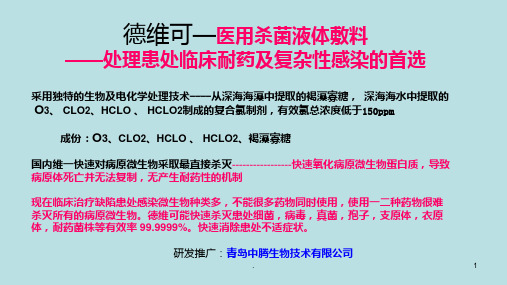
成纤维细胞
2、促进肉芽组织快速再生
褐藻寡糖
.
4
德维可(褐藻寡糖、活性氧、活性氯)-伤口安全性
2020/6/14
.
5
德维可褐藻寡糖、活性氧、活性氯-生物相容性
2020/6/14
.
6
临床消毒是消灭物品表面细菌
杀菌是杀死一切微生物,包括芽孢
• 酒精:只能杀灭细菌,不能杀灭病毒及芽孢等,对皮肤及创面有很强刺激。
◎对创面供氧增加,促进毛细血管扩张,改善微循环,加速创面愈合
◎褐藻寡糖(海洋人体卫士,海洋人体软黄金) ——抗炎症,免疫调节,促进成纤维细胞生长,促进益生菌生长
.
8
德维可——耳鼻喉科及口腔科的应用
耳鼻喉科疾病主要是病毒感染或在病毒感染的基础上继发细菌感染。耳鼻喉科疾病易反复 发作的原因:黏膜的细菌耐药及病毒难杀灭等。内服药物只能解决内源性的问题,病毒及 细菌任然在鼻腔内存在,当身体免疫力降低时会再次入侵黏膜引发炎症等不适症状。
• 生理海水:只有清洁和保持鼻腔湿润的作用。使用后鼻腔还会堵塞
• 德维可:直接喷口腔(含漱)5分钟后因牙龈炎,扁桃体炎或口腔 溃疡等引起的疼痛等不适症状迅缓解或消失.德维可能迅速氧化硫化 物等,喷涂5秒钟后口腔异味消失。
.
10
德维可——普外科的应用——解决临床耐药
使用方法
1、非接触式加压冲洗(带有喷头装置包装,清创使用) 2、非接触式喷涂(缝合切口、创面换药使用) 3、切口、创面冲洗(Ⅱ、Ⅲ类需要德维可200ml—500ml ) 4、创面的湿润包扎---浸透德维可液的无菌纱布、脱脂棉创面覆盖
传统治疗缺陷:感染微生物种类多,不能很多药物同时使用,使用一二种药物很难杀灭所有 的病原微生物。德维可能快速杀灭患处细菌,病毒,真菌,孢子,支原体,衣原体,耐药 菌株等有效率99.9999%。快速消除患处不适症状。
重组贻贝粘蛋白的表征及功效评价

生物技术进展 2023 年 第 13 卷 第 4 期 596 ~ 603Current Biotechnology ISSN 2095‑2341研究论文Articles重组贻贝粘蛋白的表征及功效评价李敏 , 魏文培 , 乔莎 , 郝东 , 周浩 , 赵硕文 , 张立峰 , 侯增淼 *西安德诺海思医疗科技有限公司,西安 710000摘要:为了推进重组贻贝粘蛋白在医疗、化妆品领域的应用,对大肠杆菌规模化发酵及纯化生产获得的重组贻贝粘蛋白进行了表征及功效评价。
经Edman 降解法、基质辅助激光解吸电离飞行时间质谱、PITC 法、非还原型SDS -聚丙烯酰胺凝胶电泳法、凝胶法、改良的Arnow 法对重组贻贝粘蛋白进行氨基酸N 端测序、相对分子量分析、氨基酸组成分析、蛋白纯度分析、内毒素含量测定、多巴含量测定;通过细胞迁移、斑马鱼尾鳍修复效果对重组贻贝粘蛋白进行功效评价。
结果显示,获得的重组贻贝粘蛋白与理论的一级结构一致,蛋白纯度达95%以上,内毒素<10 EU ·mg -1,多巴含量大于5%;重组贻贝粘蛋白浓度为60 μg ·mL -1时能够显著促进细胞增殖的活性(P <0.01);斑马鱼尾鳍面积样品组与模型对照组相比极显著增加(P <0.001)。
研究结果表明,重组贻贝粘蛋白具有显著的促细胞迁移和修复愈合的功效,具备作为生物医学材料的潜质。
关键词:贻贝粘蛋白;基因重组;生物材料;表征;功效评价DOI :10.19586/j.20952341.2023.0021 中图分类号:S985.3+1 文献标志码:ACharacterization and Efficacy Evaluation of Recombinant Mussel Adhesive ProteinLI Min , WEI Wenpei , QIAO Sha , HAO Dong , ZHOU Hao , ZHAO Shuowen , ZHANG Lifeng ,HOU Zengmiao *Xi'an DeNovo Hith Medical Technology Co., Ltd , Xi'an 710000, ChinaAbstract :In order to promote the application of recombinant mussel adhesive protein in the medical and cosmetics field , the recombi⁃nant mussel adhesive protein obtained from scale fermentation and purification of Escherichia coli was characterized and its efficacy was evaluated. Amino acid N -terminal sequencing , relative molecular weight analysis , amino acid composition analysis , protein purityanalysis , endotoxin content , dihydroxyphenylalanine (DOPA ) content of recombinant mussel adhesive protein were determined by the following methods : Edman degradation , matrix -assisted laser desorption ionization time -of -flight mass spectrometry (MALDI -TOF -MS ), phenyl -isothiocyanate (PITC ), nonreductive SDS -polyacrylamide gel electrophoresis (SDS -PAGE ), gel method , modified Ar⁃now. The efficacy of recombinant mussel adhesive protein was evaluated by cell migration and repairing effect of zebrafish tail fin. Re⁃sults showed that the obtained recombinant mussel adhesive protein was confirmed to be consistent with the theoretical primary structure , protein purity of more than 95%, endotoxin <10 EU ·mg -1, DOPA content above 5%. When the recombinant mussel adhesive protein concentration was 60 μg ·mL -1, the effect of promoting cell proliferation was the most obvious , and it had very significant activity (P <0.01). The caudal fin area of zebrafish in sample group was significantly increased compared with model control group (P <0.001). The results indicated that recombinant mussel adhesive protein can promote cell migration and repair healing and has the potential to be used as biomedical materials.Key words :mussel adhesive protein ; gene recombination ; biological materials ; representation ; efficacy evaluation贻贝粘蛋白(mussel adhesive protein , MAP )也称作贻贝足丝蛋白(mussel foot protein ,Mfps ),收稿日期:2023⁃02⁃24; 接受日期:2023⁃03⁃31联系方式:李敏 E -mail:*******************;*通信作者 侯增淼 E -mail:***********************.cn李敏,等:重组贻贝粘蛋白的表征及功效评价是海洋贝类——紫贻贝(Mytilus galloprovincalis)、厚壳贻贝(Mytilus coruscus)、翡翠贻贝(Perna viri⁃dis)等分泌的一种特殊的蛋白质,贻贝中含有多种贻贝粘蛋白,包括贻贝粘蛋白(Mfp 1~6)、前胶原蛋白(precollagens)和基质蛋白(matrix proteins)等[1]。
小而密低密度脂蛋白胆固醇(sd LDL—C)测定试剂盒(过氧化物酶法)产品技术要求mairui
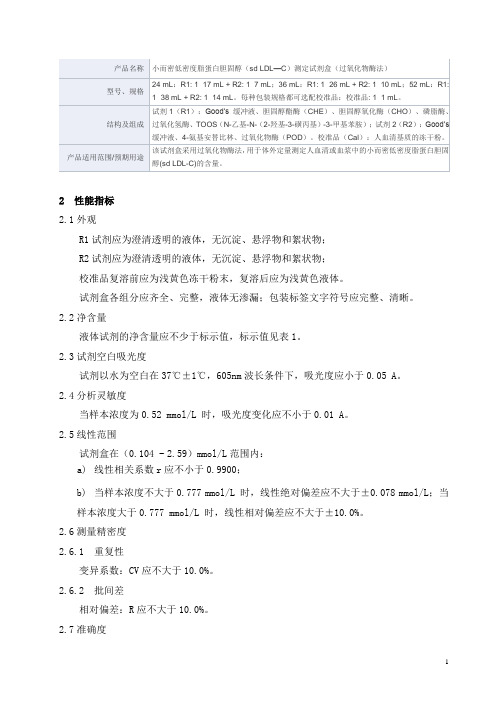
2性能指标2.1外观R1试剂应为澄清透明的液体,无沉淀、悬浮物和絮状物;R2试剂应为澄清透明的液体,无沉淀、悬浮物和絮状物;校准品复溶前应为浅黄色冻干粉末,复溶后应为浅黄色液体。
试剂盒各组分应齐全、完整,液体无渗漏;包装标签文字符号应完整、清晰。
2.2净含量液体试剂的净含量应不少于标示值,标示值见表1。
2.3试剂空白吸光度试剂以水为空白在37℃±1℃,605nm波长条件下,吸光度应小于0.05 A。
2.4分析灵敏度当样本浓度为0.52 mmol/L 时,吸光度变化应不小于0.01 A。
2.5线性范围试剂盒在(0.104 ~ 2.59)mmol/L范围内:a)线性相关系数r应不小于0.9900;b)当样本浓度不大于0.777 mmol/L 时,线性绝对偏差应不大于±0.078 mmol/L;当样本浓度大于0.777 mmol/L 时,线性相对偏差应不大于±10.0%。
2.6测量精密度2.6.1重复性变异系数:CV应不大于10.0%。
2.6.2批间差相对偏差:R应不大于10.0%。
2.7准确度1测定企业参考品,测定结果与靶值的相对偏差应不大于±10.0%。
2.8分析特异性血红蛋白浓度在500 mg/dL内、内源性酯浓度在600 mg/dL内、胆红素浓度在40mg/dL 内、抗坏血酸在50mg/dL内,对试剂检测结果的偏差影响在±10.0%范围内。
2.9校准品均一性试剂盒校准品的瓶内均一性:CV应不大于10.0%。
2.10生物安全性校准品的HBsAg、HIV抗体、HCV抗体、梅毒螺旋体TP抗体检测应为阴性。
2。
关于羟乙基淀粉的描述
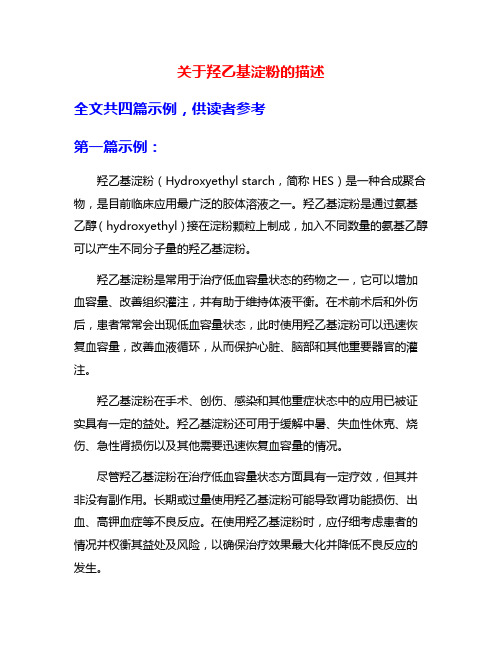
关于羟乙基淀粉的描述全文共四篇示例,供读者参考第一篇示例:羟乙基淀粉(Hydroxyethyl starch,简称HES)是一种合成聚合物,是目前临床应用最广泛的胶体溶液之一。
羟乙基淀粉是通过氨基乙醇(hydroxyethyl)接在淀粉颗粒上制成,加入不同数量的氨基乙醇可以产生不同分子量的羟乙基淀粉。
羟乙基淀粉是常用于治疗低血容量状态的药物之一,它可以增加血容量、改善组织灌注,并有助于维持体液平衡。
在术前术后和外伤后,患者常常会出现低血容量状态,此时使用羟乙基淀粉可以迅速恢复血容量,改善血液循环,从而保护心脏、脑部和其他重要器官的灌注。
羟乙基淀粉在手术、创伤、感染和其他重症状态中的应用已被证实具有一定的益处。
羟乙基淀粉还可用于缓解中暑、失血性休克、烧伤、急性肾损伤以及其他需要迅速恢复血容量的情况。
尽管羟乙基淀粉在治疗低血容量状态方面具有一定疗效,但其并非没有副作用。
长期或过量使用羟乙基淀粉可能导致肾功能损伤、出血、高钾血症等不良反应。
在使用羟乙基淀粉时,应仔细考虑患者的情况并权衡其益处及风险,以确保治疗效果最大化并降低不良反应的发生。
羟乙基淀粉的使用也存在一些争议。
一些研究发现,长期使用羟乙基淀粉可能与肾功能损伤、出血、感染等并发症相关。
一些学术组织已经提出了限制或禁止使用羟乙基淀粉的建议,鼓励医生在治疗低血容量状态时选择其他替代方法,如晶体溶液或胶体代用品。
在使用羟乙基淀粉时,应根据患者的具体情况和治疗需求,仔细选择剂量和使用时机,并定期监测患者的生命体征、肾功能等指标,以确保治疗效果和患者安全。
医务人员在使用羟乙基淀粉时应严格遵循规范的操作流程并注意患者的随访管理,及时发现并处理不良反应。
羟乙基淀粉是一种有效的血容量扩充剂,在一些特定情况下可以帮助患者快速恢复血容量、改善组织灌注,但在使用时需谨慎选择和监测,以避免潜在的不良反应和并发症的发生。
对于使用羟乙基淀粉治疗的患者,医务人员需充分评估患者的病情和病史,并根据临床指南和最新研究结果进行治疗决策,以达到最佳的治疗效果。
布地奈德分子式
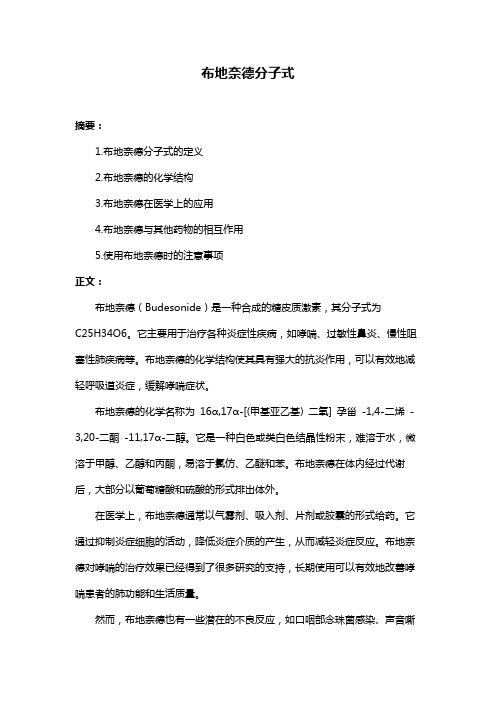
布地奈德分子式摘要:1.布地奈德分子式的定义2.布地奈德的化学结构3.布地奈德在医学上的应用4.布地奈德与其他药物的相互作用5.使用布地奈德时的注意事项正文:布地奈德(Budesonide)是一种合成的糖皮质激素,其分子式为C25H34O6。
它主要用于治疗各种炎症性疾病,如哮喘、过敏性鼻炎、慢性阻塞性肺疾病等。
布地奈德的化学结构使其具有强大的抗炎作用,可以有效地减轻呼吸道炎症,缓解哮喘症状。
布地奈德的化学名称为16α,17α-[(甲基亚乙基) 二氧] 孕甾-1,4-二烯-3,20-二酮-11,17α-二醇。
它是一种白色或类白色结晶性粉末,难溶于水,微溶于甲醇、乙醇和丙酮,易溶于氯仿、乙醚和苯。
布地奈德在体内经过代谢后,大部分以葡萄糖酸和硫酸的形式排出体外。
在医学上,布地奈德通常以气雾剂、吸入剂、片剂或胶囊的形式给药。
它通过抑制炎症细胞的活动,降低炎症介质的产生,从而减轻炎症反应。
布地奈德对哮喘的治疗效果已经得到了很多研究的支持,长期使用可以有效地改善哮喘患者的肺功能和生活质量。
然而,布地奈德也有一些潜在的不良反应,如口咽部念珠菌感染、声音嘶哑、皮肤刺激等。
因此,在使用布地奈德时,患者应遵循医生的建议,并注意以下几点:1.遵医嘱:使用布地奈德时,一定要遵循医生的处方和指导,切勿自行调整剂量或停药。
2.正确使用:掌握正确的用药方法,如使用气雾剂时,需摇匀并深吸,避免药物沉积在口腔和喉咙。
3.定期检查:使用布地奈德期间,应定期进行相关检查,如肺功能检查、血糖、血压等,以监测药物疗效和潜在的不良反应。
4.注意药物相互作用:布地奈德与其他糖皮质激素、抗真菌药等药物可能存在相互作用,使用时需告知医生自己正在使用的其他药物。
5.避免滥用:长期滥用布地奈德可能导致药物依赖、激素撤退综合症等不良反应,因此,在使用过程中,应遵循医生的建议,逐步减量至停药。
总之,布地奈德作为一种糖皮质激素,具有强大的抗炎作用,对治疗哮喘等炎症性疾病具有良好的疗效。
莫西沙星杂质结构式
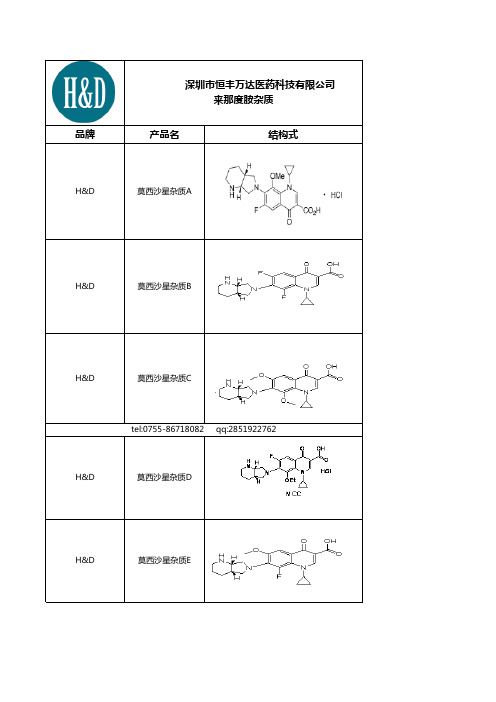
莫西沙星杂质C
tel:0755-867180ຫໍສະໝຸດ 2qq:2851922762
H&D
莫西沙星杂质D
H&D
莫西沙星杂质E
H&D
莫西沙星杂质F
深圳市恒丰万达医药科技有限公司:贝尼地平杂质,维格列汀杂质,考尼伐坦杂质,来 那替尼杂质,奥拉帕尼杂质,依托考昔杂质,氯吡格雷杂质,帕拉米韦杂质。
2851922762hdhdhd深圳市恒丰万达医药科技有限公司来那度胺杂质莫西沙星杂质a莫西沙星杂质b莫西沙星杂质c莫西沙星杂质d莫西沙星杂质e莫西沙星杂质f深圳市恒丰万达医药科技有限公司
深圳市恒丰万达医药科技有限公司 来那度胺杂质 品牌 产品名 结构式
H&D
莫西沙星杂质A
H&D
莫西沙星杂质B
H&D
稀甘油
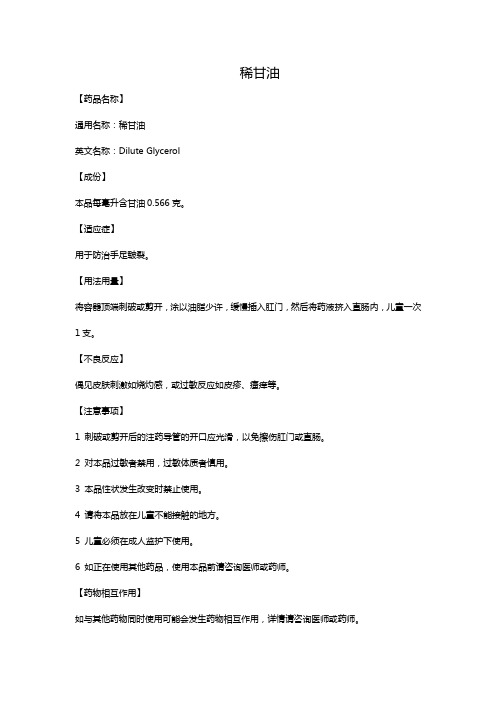
稀甘油
【药品名称】
通用名称:稀甘油
英文名称:Dilute Glycerol
【成份】
本品每毫升含甘油0.566克。
【适应症】
用于防治手足皲裂。
【用法用量】
将容器顶端刺破或剪开,涂以油脂少许,缓慢插入肛门,然后将药液挤入直肠内,儿童一次1支。
【不良反应】
偶见皮肤刺激如烧灼感,或过敏反应如皮疹、瘙痒等。
【注意事项】
1 刺破或剪开后的注药导管的开口应光滑,以免擦伤肛门或直肠。
2 对本品过敏者禁用,过敏体质者慎用。
3 本品性状发生改变时禁止使用。
4 请将本品放在儿童不能接触的地方。
5 儿童必须在成人监护下使用。
6 如正在使用其他药品,使用本品前请咨询医师或药师。
【药物相互作用】
如与其他药物同时使用可能会发生药物相互作用,详情请咨询医师或药师。
【药理作用】
本品能润滑并刺激肠壁,软化大便,使易于排出。
【贮藏】
遮光,密封,在干燥凉暗处保存。
【批准文号】
国药准字H13023410
【生产企业】
企业名称:北京御生堂集团石家庄制药有限公司生产地址:鹿泉市南降壁开发区。
- 1、下载文档前请自行甄别文档内容的完整性,平台不提供额外的编辑、内容补充、找答案等附加服务。
- 2、"仅部分预览"的文档,不可在线预览部分如存在完整性等问题,可反馈申请退款(可完整预览的文档不适用该条件!)。
- 3、如文档侵犯您的权益,请联系客服反馈,我们会尽快为您处理(人工客服工作时间:9:00-18:30)。
Inhibitors, Agonists, Screening LibrariesSafety Data Sheet Revision Date:May-24-2017Print Date:May-24-20171. PRODUCT AND COMPANY IDENTIFICATION1.1 Product identifierProduct name :Dexmedetomidine (hydrochloride)Catalog No. :HY-17034ACAS No. :145108-58-31.2 Relevant identified uses of the substance or mixture and uses advised againstIdentified uses :Laboratory chemicals, manufacture of substances.1.3 Details of the supplier of the safety data sheetCompany:MedChemExpress USATel:609-228-6898Fax:609-228-5909E-mail:sales@1.4 Emergency telephone numberEmergency Phone #:609-228-68982. HAZARDS IDENTIFICATION2.1 Classification of the substance or mixtureGHS Classification in accordance with 29 CFR 1910 (OSHA HCS)Acute toxicity, Oral (Category 4),H302Acute aquatic toxicity (Category 1),H400Chronic aquatic toxicity (Category 1),H4102.2 GHS Label elements, including precautionary statementsPictogramSignal word WarningHazard statement(s)H302 Harmful if swallowed.H410 Very toxic to aquatic life with long lasting effects.Precautionary statement(s)H302 Harmful if swallowed.H410 Very toxic to aquatic life with long lasting effects.2.3 Other hazardsNone.3. COMPOSITION/INFORMATION ON INGREDIENTS3.1 SubstancesSynonyms:(+)⁻Medetomidine hydrochloride; (S)⁻Medetomidine hydrochlorideFormula:C13H17ClN2Molecular Weight:236.74CAS No. :145108-58-34. FIRST AID MEASURES4.1 Description of first aid measuresEye contactRemove any contact lenses, locate eye-wash station, and flush eyes immediately with large amounts of water. Separate eyelids with fingers to ensure adequate flushing. Promptly call a physician.Skin contactRinse skin thoroughly with large amounts of water. Remove contaminated clothing and shoes and call a physician.InhalationImmediately relocate self or casualty to fresh air. If breathing is difficult, give cardiopulmonary resuscitation (CPR). Avoid mouth-to-mouth resuscitation.IngestionWash out mouth with water; Do NOT induce vomiting; call a physician.4.2 Most important symptoms and effects, both acute and delayedThe most important known symptoms and effects are described in the labelling (see section 2.2).4.3 Indication of any immediate medical attention and special treatment neededTreat symptomatically.5. FIRE FIGHTING MEASURES5.1 Extinguishing mediaSuitable extinguishing mediaUse water spray, dry chemical, foam, and carbon dioxide fire extinguisher.5.2 Special hazards arising from the substance or mixtureDuring combustion, may emit irritant fumes.5.3 Advice for firefightersWear self-contained breathing apparatus and protective clothing.6. ACCIDENTAL RELEASE MEASURES6.1 Personal precautions, protective equipment and emergency proceduresUse full personal protective equipment. Avoid breathing vapors, mist, dust or gas. Ensure adequate ventilation. Evacuate personnel to safe areas.Refer to protective measures listed in sections 8.6.2 Environmental precautionsTry to prevent further leakage or spillage. Keep the product away from drains or water courses.6.3 Methods and materials for containment and cleaning upAbsorb solutions with finely-powdered liquid-binding material (diatomite, universal binders); Decontaminate surfaces and equipment by scrubbing with alcohol; Dispose of contaminated material according to Section 13.7. HANDLING AND STORAGE7.1 Precautions for safe handlingAvoid inhalation, contact with eyes and skin. Avoid dust and aerosol formation. Use only in areas with appropriate exhaust ventilation.7.2 Conditions for safe storage, including any incompatibilitiesKeep container tightly sealed in cool, well-ventilated area. Keep away from direct sunlight and sources of ignition.Recommended storage temperature:Powder-20°C 3 years4°C 2 yearsIn solvent-80°C 6 months-20°C 1 monthShipping at room temperature if less than 2 weeks.7.3 Specific end use(s)No data available.8. EXPOSURE CONTROLS/PERSONAL PROTECTION8.1 Control parametersComponents with workplace control parametersThis product contains no substances with occupational exposure limit values.8.2 Exposure controlsEngineering controlsEnsure adequate ventilation. Provide accessible safety shower and eye wash station.Personal protective equipmentEye protection Safety goggles with side-shields.Hand protection Protective gloves.Skin and body protection Impervious clothing.Respiratory protection Suitable respirator.Environmental exposure controls Keep the product away from drains, water courses or the soil. Cleanspillages in a safe way as soon as possible.9. PHYSICAL AND CHEMICAL PROPERTIES9.1 Information on basic physical and chemical propertiesAppearance White to off-white (Solid)Odor No data availableOdor threshold No data availablepH No data availableMelting/freezing point No data availableBoiling point/range No data availableFlash point No data availableEvaporation rate No data availableFlammability (solid, gas)No data availableUpper/lower flammability or explosive limits No data availableVapor pressure No data availableVapor density No data availableRelative density No data availableWater Solubility No data availablePartition coefficient No data availableAuto-ignition temperature No data availableDecomposition temperature No data availableViscosity No data availableExplosive properties No data availableOxidizing properties No data available9.2 Other safety informationNo data available.10. STABILITY AND REACTIVITY10.1 ReactivityNo data available.10.2 Chemical stabilityStable under recommended storage conditions.10.3 Possibility of hazardous reactionsNo data available.10.4 Conditions to avoidNo data available.10.5 Incompatible materialsStrong acids/alkalis, strong oxidising/reducing agents.10.6 Hazardous decomposition productsUnder fire conditions, may decompose and emit toxic fumes.Other decomposition products - no data available.11.TOXICOLOGICAL INFORMATION11.1 Information on toxicological effectsAcute toxicityClassified based on available data. For more details, see section 2Skin corrosion/irritationClassified based on available data. For more details, see section 2Serious eye damage/irritationClassified based on available data. For more details, see section 2Respiratory or skin sensitizationClassified based on available data. For more details, see section 2Germ cell mutagenicityClassified based on available data. For more details, see section 2CarcinogenicityIARC: No component of this product present at a level equal to or greater than 0.1% is identified as probable, possible or confirmed human carcinogen by IARC.ACGIH: No component of this product present at a level equal to or greater than 0.1% is identified as a potential or confirmed carcinogen by ACGIH.NTP: No component of this product present at a level equal to or greater than 0.1% is identified as a anticipated or confirmed carcinogen by NTP.OSHA: No component of this product present at a level equal to or greater than 0.1% is identified as a potential or confirmed carcinogen by OSHA.Reproductive toxicityClassified based on available data. For more details, see section 2Specific target organ toxicity - single exposureClassified based on available data. For more details, see section 2Specific target organ toxicity - repeated exposureClassified based on available data. For more details, see section 2Aspiration hazardClassified based on available data. For more details, see section 212. ECOLOGICAL INFORMATION12.1 ToxicityNo data available.12.2 Persistence and degradabilityNo data available.12.3 Bioaccumlative potentialNo data available.12.4 Mobility in soilNo data available.12.5 Results of PBT and vPvB assessmentPBT/vPvB assessment unavailable as chemical safety assessment not required or not conducted.12.6 Other adverse effectsNo data available.13. DISPOSAL CONSIDERATIONS13.1 Waste treatment methodsProductDispose substance in accordance with prevailing country, federal, state and local regulations.Contaminated packagingConduct recycling or disposal in accordance with prevailing country, federal, state and local regulations.14. TRANSPORT INFORMATIONDOT (US)This substance is considered to be non-hazardous for transport.IMDGUN number: 3077Class: 9Packing group: IIIEMS-No: F-A, S-FProper shipping name: ENVIRONMENTALLY HAZARDOUS SUBSTANCE, SOLID, N.O.S.Marine pollutant: Marine pollutantIATAUN number: 3077Class: 9Packing group: IIIProper shipping name: Environmentally hazardous substance, solid, n.o.s.15. REGULATORY INFORMATIONSARA 302 Components:No chemicals in this material are subject to the reporting requirements of SARA Title III, Section 302.SARA 313 Components:This material does not contain any chemical components with known CAS numbers that exceed the threshold (De Minimis)reporting levels established by SARA Title III, Section 313.SARA 311/312 Hazards:No SARA Hazards.Massachusetts Right To Know Components:No components are subject to the Massachusetts Right to Know Act.Pennsylvania Right To Know Components:No components are subject to the Pennsylvania Right to Know Act.New Jersey Right To Know Components:No components are subject to the New Jersey Right to Know Act.California Prop. 65 Components:This product does not contain any chemicals known to State of California to cause cancer, birth defects, or anyother reproductive harm.16. OTHER INFORMATIONCopyright 2017 MedChemExpress. The above information is correct to the best of our present knowledge but does not purport to be all inclusive and should be used only as a guide. The product is for research use only and for experienced personnel. It must only be handled by suitably qualified experienced scientists in appropriately equipped and authorized facilities. The burden of safe use of this material rests entirely with the user. MedChemExpress disclaims all liability for any damage resulting from handling or from contact with this product.Caution: Product has not been fully validated for medical applications. For research use only.Tel: 609-228-6898 Fax: 609-228-5909 E-mail: tech@Address: 1 Deer Park Dr, Suite Q, Monmouth Junction, NJ 08852, USA。
